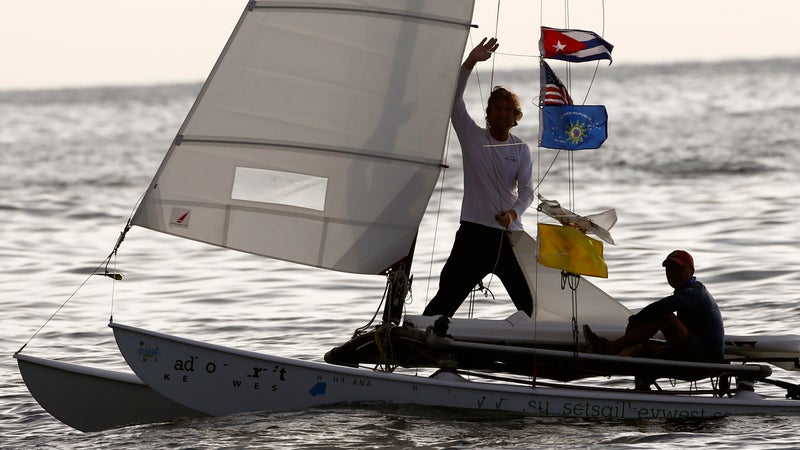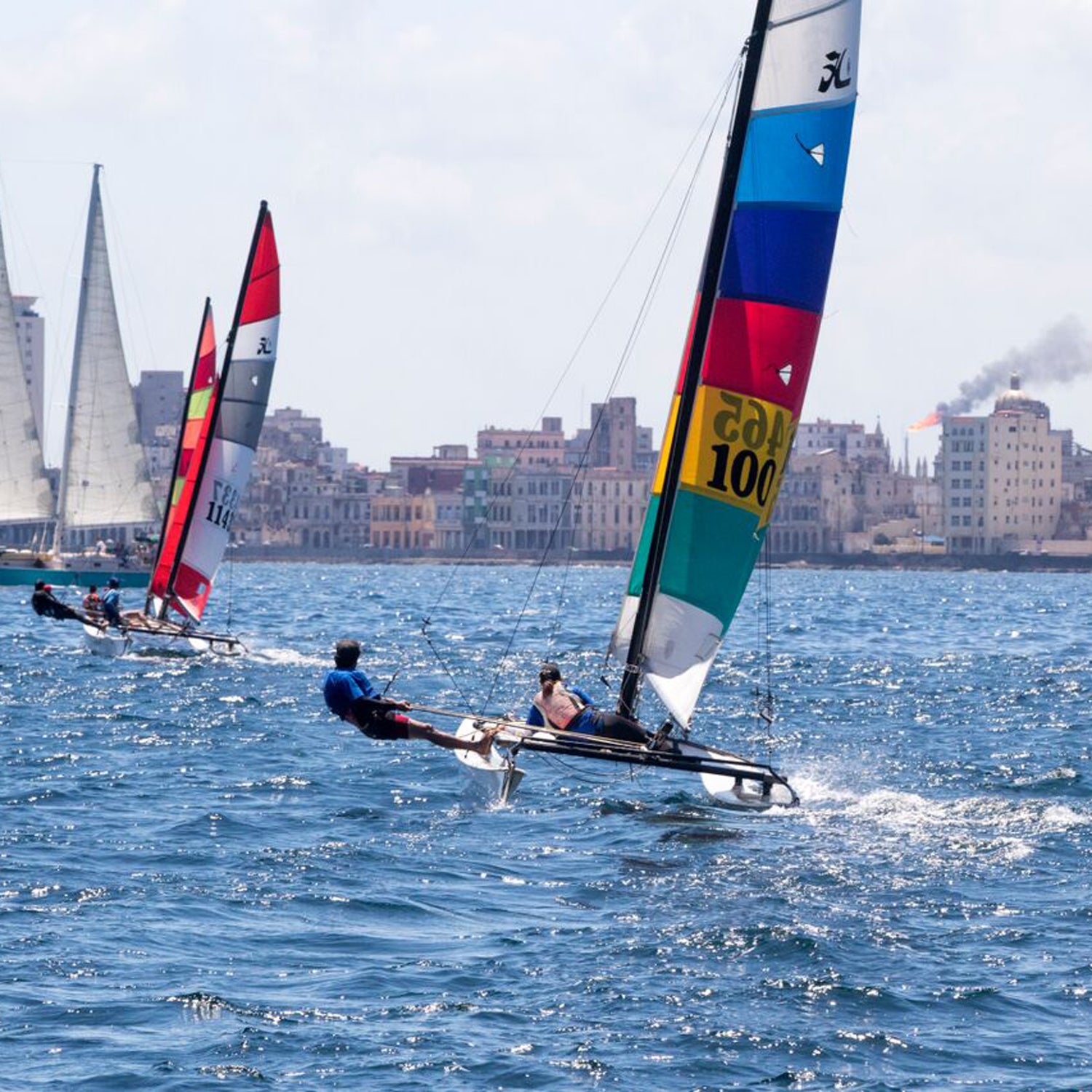The first boat to sink in the Gulf Stream 100—the first government-sanctioned race from Key West to Havana since the easing of diplomatic relations between the two countries—did so just 30 miles into the race. Buffeted by big seas, the rudder ripped from the starboard hull, which began taking on water. A towline soon damaged the other hull, and the little catamaran was hauled in pieces aboard the 72-foot Ocean Star, a lumbering gray salvage boat.
“If one Hobie Cat makes it, I’ll be surprised,” said Phil Shuff, captain of the fleet’s lead support boat, the 57-foot Bella Donna.��
It’s Saturday, May 16.��Three hours earlier, a crowd and news cameras gathered at the foot of Duval Street in Key West to witness the start of the race.��The boats had nearly 70 miles to go, and it seemed like only a miracle could get them Havana. “This all runs on adrenaline and optimism,” said Joe Weatherby, the 53-year-old former Wall Street trader who now builds artificial reefs and helped organize this race.��
A mere six months earlier, it seemed impossible that five Hobie Cats and 14 support boats would have legal permission to make the trip. But things change. Sixty years ago, yachts cruised to Cuba from all over Florida—St. Petersburg, Sarasota, Miami. Key West even ran daily ferry service to Havana, then a destination more lurid than Las Vegas. The climate and a cosmopolitan, libertine atmosphere attracted Graham Greene, Frank Sinatra, Ava Gardner, and, most famously, Ernest Hemingway, who periodically lived in and around Havana for 20 years.
All of that ceased after the 1959 revolution that deposed strongman Fulgencio Batista and installed the Castros to power. In 1961, the United States broke off diplomatic relations with Cuba. For the next 50 years, the only people crossing the straits were los balseros (the rafters who risk everything for el norte), smugglers, and the occasional intrepid sailor or fisherman who defied the authorities.��

Weatherby and his longtime friend George Bellenger, a sailor with thick silver hair that is the envy of any politician, fell into the latter group. As Weatherby says, “George has been thrown out of Cuba more times than Sloppy Joe’s,” a famously rowdy Key West bar. The two met at the University of Delaware in the early 1980s, came to Key West on spring break, and have remained, on and off, ever since.
In October 1996, the duo sailed a Hobie Cat to Cuba without Coast Guard approval, guidebooks, or a plan other than heading south. The crossing took nine hours, followed by a four-hour paddle to Marina Hemingway, west of Havana. “We were denied visas,” Bellenger says. “Turns out you needed a passport to visit Cuba.” But instead of staying at the marina complex as ordered, they snuck into Havana to eat and drink their way through the city’s old quarter. The harbormaster busted them on their return and ordered them to leave in the morning.
“The seas were 20-plus feet,” Bellenger recalls. “The boat was falling apart. We literally had to use some string to hold the mast up. All our navigation equipment broke except Joe’s wristwatch compass.”
When they returned, they vowed to make the trip again. Bellenger did so a dozen times over the next five years—five of them on a Hobie Cat—often accompanied by his wife, Carla, as well as Weatherby and other friends. But the threat of prosecution in the tense post-9/11 political atmosphere halted his adventures.
Miller and Salzmann were gaining ground when they struck something and their boat plunged underwater. From a support boat, Salzmann’s father screamed, “Shark!” A fin surfaced, followed by a geyser of air. They had hit a breaching whale.
In April 2014, sensing that the political situation was in flux, the Bellengers and Weatherby launched a campaign to be the first to make a sanctioned crossing. The timing was fortuitous. In December, President Obama and Cuban president Raul Castro announced plans to normalize relations. In May, Cuba was removed from a U.S. list of state sponsors of terrorism. In July, the two countries reopened embassies. On August 14, Secretary of State John Kerry will visit Cuba to raise a U.S. flag at the embassy in Havana. It all appeared almost effortless.
Yet there were reasons Weatherby and the Bellengers called their expedition the Havana Challenge—they spent a year navigating an array of federal offices, including the departments of commerce, defense, and state. Bellenger wrote a letter appealing for help to the office of Vice President Joe Biden, a fellow Delaware native. Key West mayor Craig Cates enlisted the city’s lobbyist in Washington, DC. Pat Croce, a former owner of the Philadelphia 76ers—and proprietor of six Key West bars—leaned on friends in the federal government.��
It took more than a year, but the event finally received its permits just hours before the May 15 departure. Across Key West, a scramble had been on for coveted spots in the fleet, which were advertised via what locals call “the coconut telegraph,” or word of mouth. Bellenger and Weatherby personally approved all the sailors and powerboat captains, most of whom were acquaintances, colleagues, and characters known for excellence on the water. “We’ve got a couple very rich people on this trip,” Weatherby said in a gravelly South Jersey accent, “and we’ve got the boys from the dock.”
At Schooner Wharf, a tavern thick with sticky sea air and nautical bric-a-brac, charter boat captains Wade Miller and Seth Salzmann formed their partnership over drinks, found a Hobie Cat on Craigslist for $1,200, and signed on. “Going to Cuba, getting in a 1950s car, talking Spanish—those are things I had never done before,” Miller said about the race’s appeal.
Tim Flanagan and Eric Youtz were pumping poop from a boat at Sebago Watersports when they agreed to team up. “For us, it was the forbidden fruit,” Flanagan explained. “You hear in the American media how it is to come from Cuba. We had to go see.” They bought a used Hobie Cat for $2,400 and named it Goat Rodeo.��
The problem with racing on Hobie Cats is that the crafts are better for day sailing than deep water. The 12-knot winds and 10-foot swells proved difficult as soon as the race began. When that first Hobie went down, the boat’s captain, Rio O’Bryan, had to dive to untangle the towline from a propeller. “I thought a mako was going to come up on us,” O’Bryan said. “I was thinking for sure I was going to lose a leg.”
Ahead, Doug Conner, 59, and Jeff Stotts, 58, soon capsized in the middle of the Gulf Stream. The oldest sailors in the race, they had dubbed themselves Team Advil because they required so much pain reliever. They drifted more than three miles before they finally gave up, climbed aboard a support boat, and watched their craft slip beneath the waves.��
The other sailors fared scarcely better as they chased first-place Wil Kinsey and John McCandless, a seaplane pilot known as Johnny Dread, and their Hobie, called Wolbem (an anagram of “blow me”). Miller and Salzmann were gaining ground when they struck something and their boat plunged underwater. From a support boat, Salzmann’s father screamed, “Shark!” A fin surfaced, followed by a geyser of air—they had hit a breaching whale. They righted the boat and sailed on, having lost precious time.
Behind them, Goat Rodeo surfed down a six-foot growler, buried its bows, and flipped, with Flanagan falling on Youtz’s face and bloodying his nose. Swinging the mast back into the wind, they reached the sea buoy off Marina Hemingway an hour and a half later, at 6:30 p.m., to take third—out of three remaining boats.
The sailors were exhausted at customs, but there was little time to rest. They had three days to recover and repair their Hobies before sailing against members of Cuba’s national teams in a regatta off the Malecon, Havana’s seawall.
The list of repairs was long: Only two of the Hobies had completed the crossing entirely intact. But the Cuban competitors—most of them teenagers—were eager to help, scavenging parts from the wreckage of O’Connor and O’Bryan’s boat, employing ingenuity and repurposing practices prevalent in a country where American cars from the 1950s are still in service. With fiberglass and epoxy, they helped the Americans patch holes on the hulls. They sanded. They tightened the trampolines.
Meanwhile, the sailors toured the city. In the bars of Habana Vieja, they heard salsa, mambo, and, always, “Guantanamera.” (Weatherby, in his Tom Waits growl, changed its lyrics to “One-ton-a-ganja.”) They pursued Hemingway, whose ghost is everywhere in Cuba. They cruised the long curve of the Malecon in an aqua 1953 Chevy Deluxe convertible, inhaling the sea and smoke from a Cohiba.
In time capsule Cuba, they recorded change.
“One thing I noticed on this trip was the lack of large billboards espousing the party line,” said Bellenger. “You don’t see a lot of ‘socialism or death’ or ‘capitalistic imperial pig’ billboards.”
The Cuban sailors easily swept the regatta. After all, the Hobie captains were “a bunch of water kooks enjoying a beautiful day,” as Johnny Dread said.
Finally, on Tuesday, May 19, beneath brilliant nimbus skies, the surviving refitted Hobie fleet raced members of the Cuban national team on a course between the U.S. Special Interests Section building—which on Monday, July 20, was reestablished as the U.S. embassy after 54 years—and the grand Hotel Nacional, operated by the likes of Meyer Lansky and Lucky Luciano before the revolutionaries expelled the gangsters.��
The Cuban sailors easily swept the regatta. After all, the Hobie captains were “a bunch of water kooks enjoying a beautiful day,” as Johnny Dread said.
After the race, Jose Miguel Diaz Escrich, a former naval office and current commodore of the Hemingway International Yacht Club, led an awards ceremony. He favored double-breasted blue blazers and boat shoes and spoke in the stentorian tones of a Latin American military leader. “It was a real challenge to come here,” he said through a translator. “I think the people coming across, the Hobie Cat racers, their motivation to face strong wind and waves was amazing.”
“We are right in history!” he said, poking the air with his index finger. “We are riding in a boat of history between Key West and Havana, contributing to a relationship between the U.S. and Cuba to bring down a policy in which hatred has been the leader. Take down hatred and put love instead!”
The next day, the commodore led the American fleet on a historic parade into Havana Harbor, where crowds of Habaneros yelled from shore. The Bella Donna, he said, was the first boat under the American flag in Havana Harbor in some 50 years.


